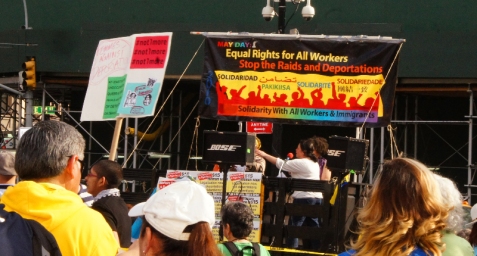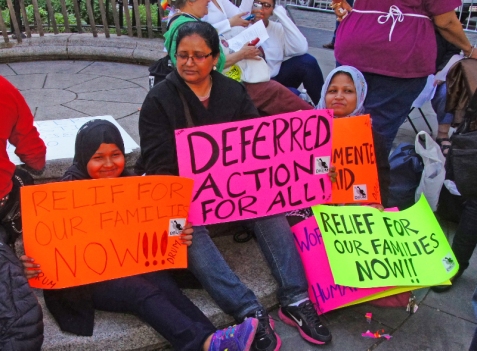Hello,
this is John Robles. I’m speaking with Mr. Nathan Folks, he is a well
known US based film and TV director and producer. He is also one of the
organizers of the Worldwide Wave of Action and a truth seeker. This is
part 2 of a longer interview.
Robles:
Can you tell us more details about the Boston bombing? Who was behind
it exactly and the scheme where they made millions of dollars, as many
details as you can, I would appreciate it...
Folks:
I think there needs to be an investigation into the One Boston Fund and
the money that millions of people gave to that fund which was a
complete fraud. And I think that people that are making money of this
need to be investigated and by doing so I think the truth will come out.
But I also believe that if you do a little bit of homework of who
actually is running One Boston Fund that supported a lot of this, it
goes right up the line to Homeland Security and the people that wrote
books on this exact nature. I am not going to name names but it is all
on the writing. It is all documents, it is all there, it is just no one
wants to read it and admit it.
Robles: What
was the connection with Sandy Hook? Because there was some connection
to some crisis actors from Sandy Hook and some people that were funding
the Boston fund.
Folks:
Yeah, it is very evident that there is a family, a very specific
family, I believe the name is Greenberg, that has been used several
times in several different events: in Sandy Hook they were the crying
parents of one of the deceased boys.
Well, the same
woman, the same man they were both used in several different instances,
in several different events that have taken place in the last several
years and they use the crisis actors over and over. They pay them off
once and you know... I won’t be surprised when Carlos Arredondo is
another hero of another event...
Robles: And he was at Boston, he was the..
Folks:
Carlos Arredondo was the man in a cowboy hat, he was the Boston hero by
getting these non-bleeding two-legged-blown-off man to safety.
If
they honestly believe that we all think that is real, then they have
another thing coming because that is the biggest joke I have ever seen.
Robles: I
remember I studied the photographs of him running through the streets
and just the expressions on all of the people’s faces was enough to tell
me something was wrong. I mean I remember there was all these people
apparently laying on the road and I think...
Folks:
Oh yeah. The production designers in the scenes, I mean the makeup
artist is in the scene helping everyone and then all of a sudden she is
injured, you know, there is pictures of her being injured at the end. I
mean, it is just so unbelievably ridiculous that I don’t want this to
happen again, I don’t want them to put the country through this again.
Robles:
It wasn’t just the country it was the world? I mean, I’m sitting here
in Moscow, this was a pretty big thing for us. I mean, we were reporting
it all night.
Folks: Yeah, you are right, it is putting the country in chaos and it is wrong.
You
know, I know a friend of mine that has kids in school and the kid in
school; it traumatized her for months after Sandy Hook. You know, this
is just wrong what they are doing. And for whatever reasons they are
doing it, it has got to be stopped.
And it’s out and
they are going to come after me and they are going to say: “Oh yes he
has no remorse for people that have been killed and no remorse for the
injured.”
And I want to say: “You know what? Prove it!”
I
want to interview every doctor that was used in the Boston Bombing, I’d
like to find out where that money really went for the One Boston Fund, I
want them to prove it, you know.
If they are going to
come out against me and start saying: “Oh, well he has no feelings for
all these people that have been killed.”
Well, I put it
back on them. The world know that this was a sham but no one wants to
talk about it. But if they are going to come out and the they want to
actually say: “This was real!”
Then I want them to come
out and prove it other than these pictures or this media they put on
the news. I want to see real proof, because that is what they make us
do! Come up with real proof. Let’s see them come up with real proof.
Robles: Can
you tell us about the Tsarnaev brothers, I’m sure they would like to
see proof and their parents would and their father would and their
mother would.
Folks:
Well, in my opinion I think they were working with the FBI. I think
that most of these incidences they are working with certain government
companies, organizations.
I think they would like to
see the proof too. I know that there were some lawsuits coming out
against certain people that were blamed at first about the incident and I
know why he is trying to sue, it is because his name was ruined in an
event that never really happened.
So, I’d say: “You
know what, join the lawsuit, prove to us and the world that this
actually existed and then we will tell you how we really think.”
Robles: As
a producer, as a professional with your professional acumen and with a
cold professional eye you say: “Boston was a false flag attack organized
by…?”
Folks: I believe it was organized by someone and I don’t know who.
You
can only hope that the government is not involved. You can only hope
that we are here doing the right thing, but for whatever the reason it
was not real. And anyone in the film industry will back me up that it is
very obvious how they edited it and cut and spliced that scene
together.
Robles: The biggest evidence that it was false: what would you say that would be?
Folks:
I would say that I would look at the One Boston Fund and I would find
out where that money went and I would… You know they always say: “Follow
the money”, well, I would follow the money.
I’d find
out: each one of these people who got money from this situation; why
they got money; what public relations firm based out of DC represented
all these people (I think that is another “untying” of the rope if you will), and it is just all there, it is all there.
Robles: Why aren’t people screaming about this? Why isn’t there an outcry?
Folks: Because they are controlling the media and the Internet. Even if there is an outcry no one is going to hear it.
We’ve
been subject to no more freedom of speech and our constitutional rights
here have been eliminated, because I can tell you there are millions
and millions of people, millions and millions of Americans that would
not stand for this. And I think this is the first chance we have to
start to build back any credibility that maybe we ever had.
I
think the Bush Administration, after what they have done and the lives
they’ve taken from the world, we have a lot of catching up and fixing to
do.
I think love needs to be spread now and that is the only thing that really, I’m about.
Robles: I
think the only way to restore any kind of credibility is to go after
all those people who did all this, from the torture at Guantanamo to
9-11. I think even going back to the Kennedy Assassination which they
continue to obfuscate…
Folks: These people need to be held liable for what they’ve done.
Robles: I
was happy to hear Russia’s Foreign Minister Sergey Lavrov yesterday say
that the US should be held accountable. They should take responsibility
for the coup they organized in Ukraine. But that is another entire
matter...
Can
you tell us about the Worldwide Wave of Action, what that is about and
then about your film? And if you’d like to comment on the current media
(I don’t know what it is) "alternate reality" that the US has created
regarding Ukraine.
Folks:
First Run Entertainment is releasing and distributing a film that I’ve
produced with a series of producers called: “The Prosecution of an
American President” which goes back to the Bush Administration and lies
that they told during that administration.
Vincent
Bugliosi who: is reported as one of the top prosecutors in the world;
who put Charles Manson away; who essentially wrote some of the best
books of our time, is the star of this film, showing the evidence of how
the Bush Administration lied to the people in order to convince
everyone, including Congress, to go to war. And going to a sovereign
nation that has never done anything to us and do it based on lies.
People
don’t want to hear that but it is something that needs to be said and
it needs to be faced and it will. It will eventually come out and people
will eventually do something about it.
The time is
now! The Worldwide Wave of Action is a campaign: anonymously many people
have come together worldwide to promote positive change in the world
and expose the truth and expose people that are run by evil companies
and evil corporations and evil governments and…
You know, there is
good in the world. And that good has to come out somewhere and it has
to beat this evil! They have to fight! And the Worldwide Wave of Action
is that campaign if the people let it happen.
Robles: Where can people find out more about it? Dates, times, whatever, and how to join?
Folks: People can join the Wave of Action, it’s
www dot wave of action dot org and also my site which is
www dot worldwide wave of action dot com.
We will be launching a new website, right now it is just a temporary
page but a new website will be coming out and we will have a lot more
information how the world can help and help everyone come to the truth
that we are all seeking.
Robles: Can I ask you a little bit of a personal question if you don’t mind?
Folks: Sure.
Robles:
When I first talked to you, about a year ago, you sounded different,
you sounded optimistic, you sounded younger, you sounded more innocent,
now you sound a little “tired”. How has this affected you personally if
you don’t mind me asking?
Folks:
I can tell you that this last year, 2013, was pretty much an awakening
for me on many levels. A lot of corporate and “other” situations that
are happening, that I don’t know if they are related or not but…
When
someone is sickened and put in the hospital and abused in certain ways;
you are beaten down, but the only thing that it is really to me: I may
be tired and I may be pretty much exhausted from working on all these
things, but the fire is lit brighter and harder than it has ever been.
Because now I see how much more this is important to the world and how
the film “The Prosecution of an American President” (as well as the
Worldwide Wave of Action) now, is more needed that it has ever been.
I
was naïve a year ago. I was blinded by many things and as soon as these
things came to light I saw what I needed to do, which was to step up
and start making it different and doing it now because no one else seems
to be doing it.
And the Worldwide Wave of Action I
believe is that exactly: everyone around the world coming together to
demand the truth and demand these people to be held responsible.
Robles:
Ok, “we” are going to help you any way we can, we are going to get this
out as much as we can. It was a great honor speaking with you. I really
appreciate you. I know you are actually in real danger, so we will do
our best to get this out as much as possible.
Folks: Great! Wonderful! Thank you.
Robles:
I think the best thing you can do (and the best thing we can do for
you) is publicize everything that you are saying and just for the
listeners, one more time: you were really, seriously persecuted; you had
to leave your home several times and stuff. I think you should write a
book about that sometime.
Folks: Yeah, I think that after we can get everything else out,I can finally sit down and take the time to write something. I’d like to do that.
Robles:
Is there anything you want to say about Boston to rap it up? The FBI
agents that were killed, the Tsarnaev friend that was killed… Can you
comment on those? Do you want to?
Folks:
The peripheral people that were involved, we don’t know why they were
killed, we don’t know if they were exposing the truth and then killed. I
may not be alive tomorrow because I’m talking about it.
There
are all these things that we don’t know, there are certain things we
just don’t know. But one thing we do know is that there is something
really, really smelly about this whole situation and it needs to
exposed, it needs to be investigated, even as must as the JFK
Assassination.
Robles:
As a film producer… (last comment if you could about… a little off
topic I’m sorry but) I’ve heard reports from people in the states, from
people in Ukraine, from people in Europe, that they’ve watched
television reports of tanks
rolling through the streets of Kiev, etc. etc., stuff that we know is
not happening. Is it possible in 2014 that they are fabricating all this
news?
Folks:
After Boston I could say that I’m almost positive that they are more
than likely fabricating news to create a fear and design the outcome
that they want.
When I say ‘they’ I mean the evil people that are pushing for wars and pushing for The Complex
and pushing for everything that we are not about. And yeah, I don’t see
that it would be above them to do something like that at this point! I
think that they definitely have something to do with it.
Robles:
It is a war not against terror but it is a war using terror, it is a
war that is hyped-up “on” terror I think, and they are terrorizing the
people.
Folks:
It is now a war on freedom of speech, it is now a war on the media and
it is a war on the world’s civil liberties and that is the real war we
are fighting now.
Robles: Anything else you want to finish up with or?
Folks: No, I just think that if anybody wants to get involved, join the
www.waveofaction.org or see my site at
www.worldwidewaveofaction.com which will be a platform for the film that we are releasing and all new information that comes out about this situation .
Robles: Ok, thank you very much, Nathan, I really appreciate it.
Folks: Thank you, John! Thank you so much.
This
is John Roles, you were listening to an interview with Nathan Folks, he
is a well-known US film and TV director and producer. He is also the
organizer of the Worldwide Wave of Action. You can find the rest of this
interview on our website voiceofrussia.com. Thank you very much for
listening!
Crisis
actors being positioned and made up. Notice red paint. Blood is never
such a bright red. Scene workers ignoring man with sticks attached to
his amputated legs. No blood in area where his leg was apparently
severed and what is supposed to be a bone is much too thin and straight
to be a lower leg bone. The expression on his face is the most telling
clue that something is wrong. Photo provided by Nathan Folks.






















